When Joe Biden is inaugurated on 20 January his wife, Jill, will make history as the first first lady to continue her career while her husband is in office. She follows in the footsteps of centuries of remarkable women who have shaped this complex, ever evolving, and often controversial role. Too often forgotten, they are given centre stage in Every Eye is Upon Me: First Ladies of the United States at The National Portrait Gallery in Washington, and available to view online. From Martha Washington and Dolley Madison to Eleanor Roosevelt and Michelle Obama, the exhibition celebrates the women who have used their unique status to influence political and social discourse in countless different ways.
More like this:
- A detail that decodes a masterpiece
- The images that fought Fascism
- The fine line between art and porn
As the first wife of a president of the US, Martha Washington had no precedents to follow, and relied upon European models when establishing the position. The curator Gwendolyn DuBois Shaw tells BBC Culture: "Because there was no tradition of monarchy in the new United States, the roles early first ladies began to inhabit mirrored what we had received as British colonial subjects. When Martha Washington went out in public, people called her Lady Washington because that was the language they had inherited when referring to a woman of her stature. We didn't really start calling first ladies by that name until late in the 19th Century." In a portrait painted when she and George were living in Philadelphia, then the country's capital, Martha seems to exude a mother-of-the-nation vibe, maternal yet demanding of a respect which the population seemed happy to accord her.
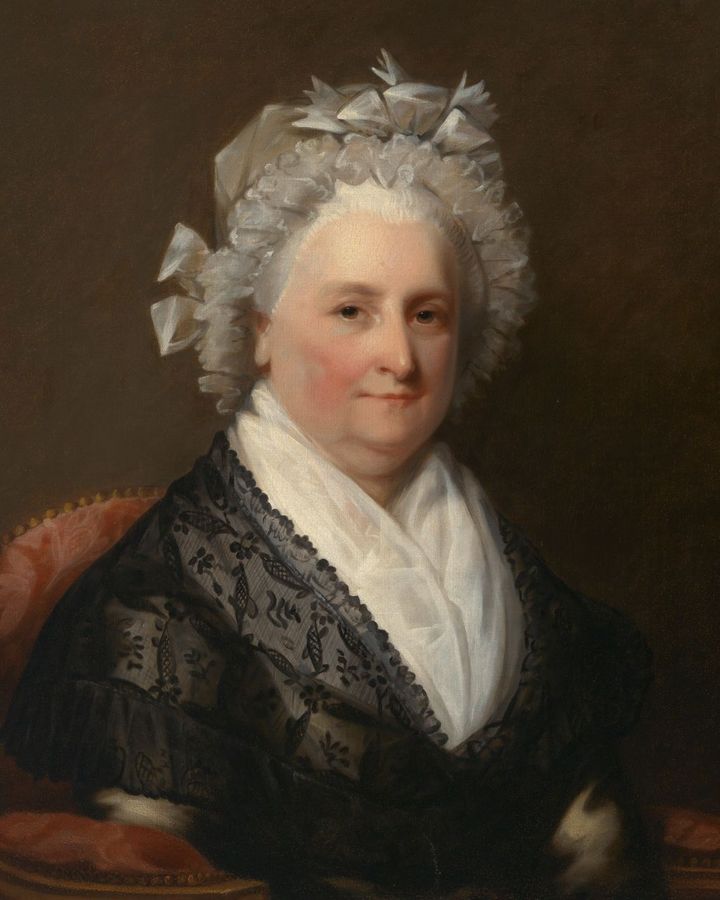
There is a mother-of-the-nation feel about the portrait of the first wife of a president, Martha Washington (Credit: National Portrait Gallery/ Smithsonian Institution)
Her successor, Abigail Adams, whose intelligence, and determination shine through in a portrait painted two years before her husband, John Adams, became president in 1797, was more politically active, advocating for women's rights, education and the abolition of slavery. "She wanted to be called Mrs President but people didn't like that, they thought she was being presumptuous," says DuBois Shaw. Adams, like many presidential wives, appears to have been living vicariously through her husband. "A good deal of these women were really smart, really ambitious and very interested in politics but gender roles precluded their ability to pursue office on their own until well into the 20th Century," says DuBois Shaw.
"Mary Lincoln was super interested in politics… she really wanted to be first lady because she couldn't be president," says DuBois Shaw. "When she gets to the White House she develops a very bad reputation. People talk about her as if she's imperious and pushy, the kind of language that is familiar to women in prominent roles in politics and business today. She's unable to be taken as someone who is well-versed in politics because of her gender."
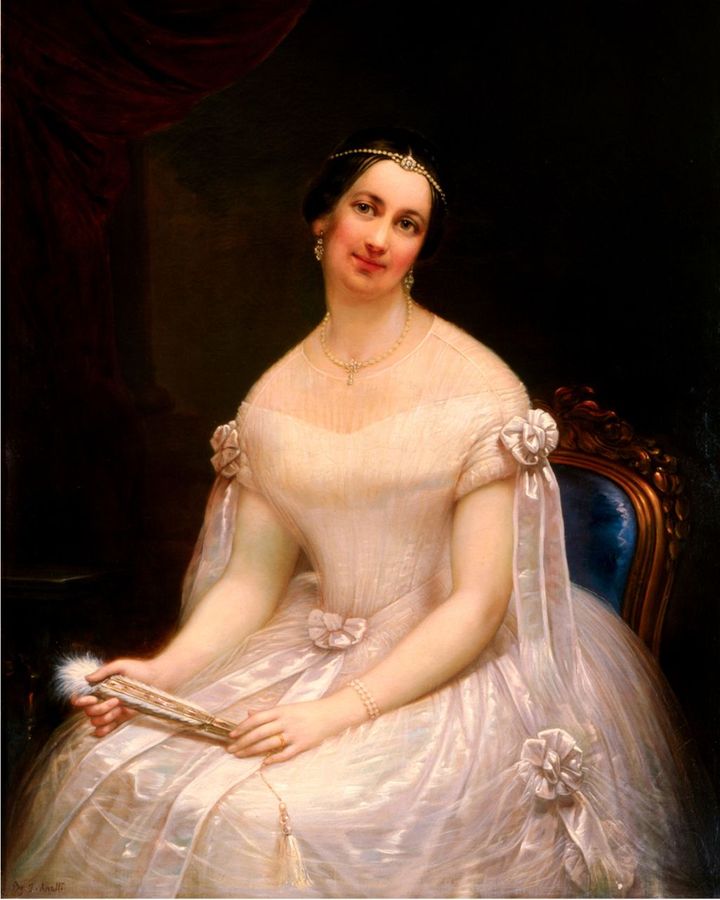
Julia Tyler resembles a princess in her portrait – as first lady, she also acted like one (Credit: Francesco Anelli/ The White House Historical Association)
With no other means available to them, many First Ladies relied on the 'soft' power that being the president's hostess gave them. Dolley Madison, who served as honorary hostess to Thomas Jefferson before continuing the role when her husband James Madison became president, was particularly noted for her diplomatic skill in bringing opponents together, and cultivated strategic friendships with both male politicians and their wives. "All that is historically discounted but so much was accomplished through these means by women in the 19th and early-20th Centuries when they didn't have other ways to achieve these things," says the curator.
The fact that Lincoln is represented in the exhibition by a carte de visite and Madison by a portrait painted many years after she was first lady is also suggestive of the way they were discounted. "Historically, most women, even elite ones, have not had their portraits professionally made," explains DuBois Shaw. "When first ladies like Caroline Harrison, Lucy Hayes or Helen Taft chose to have grand manner, full-length painted portraits made of themselves, they were making bold statements about how they viewed their own importance and impact."
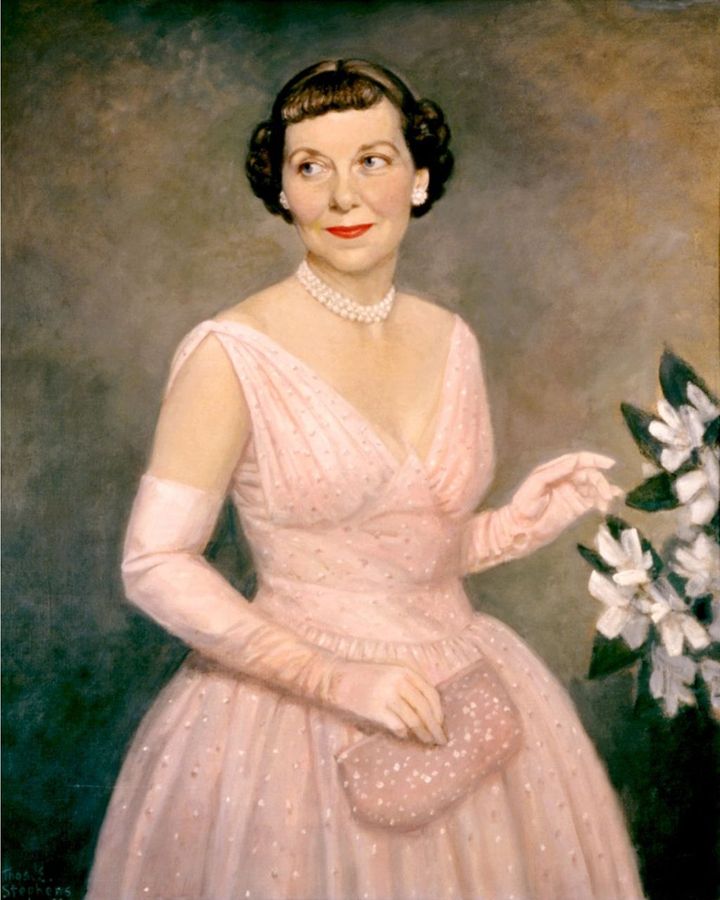
Mamie Eisenhower outwardly represented middle-class domesticity – but in fact challenged convention (Credit: Thomas Edgar Stephens/ The White House Historical Association)
DuBois Shaw singles out the portrait of Julia Tyler as particularly indicative of a strong personality. "She looks like a princess, and she acted like one too. She was responsible for the decision to have 'Hail to the Chief' played when her husband President John Tyler entered a formal event. She was trying to create a sense of European royal formality and make Washington into a court venue much like Versailles was under Louis XIV."
A force of nature
The advent of the 20th Century saw the role of first lady become increasingly public in nature, with all the scrutiny that that would entail. As the position has remained undefined, press and public opinion have frequently been divided on what exactly a first lady should be, divisions which have been influenced by wider debates on women's position in society.
Eleanor Roosevelt was undoubtedly one of the most visible and influential first ladies of the century. With Franklin D Roosevelt's mobility limited due to polio, Eleanor frequently made public appearances in his stead. At the height of the Great Depression, she travelled widely to assess federal relief programmes, and during World War Two flew around the world visiting troops in his place. Her prolific career as a writer added to her public persona and explains why she is often depicted holding a pen, as in the multi-image painting which captures the many sides of her personality featured in the exhibition. But although she is remembered as a formidable force of nature today, there was much contemporary criticism over her perceived level of influence. DuBois Shaw even came across a Democratic campaign badge saying "We don’t like Eleanor either" during her research for the exhibition. "That idea that she stepped out of line was being used by her own party," she says.
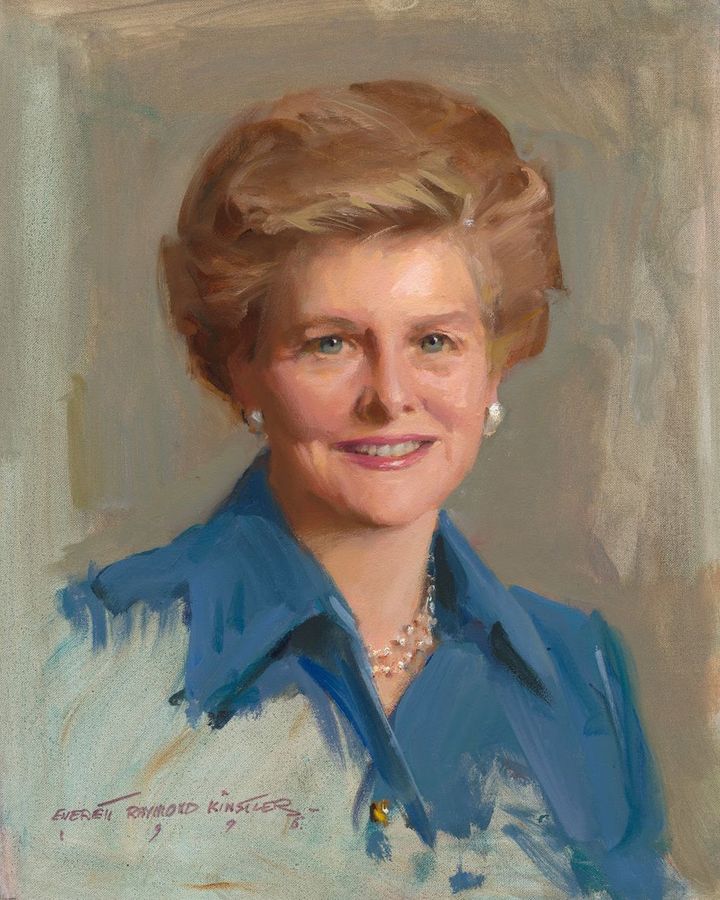
Betty Ford was frank about her drug and alcohol dependency, and later founded the Betty Ford Center (Credit: Everett Raymond Kinstler/ NPG/ Smithsonian Institution)
Mamie Eisenhower, painted in her trademark "Mamie pink" inauguration gown, seemed much more suited to a post-war conservative media's idea of a first lady. "It's women back in the kitchen, the Dior New Look," says DuBois Shaw. "People loved her because she represented this white, middle-class domesticity that was really being pushed by the media and the cultural machine that essentially wanted to turn back the clock." But despite her outward image she was not afraid to challenge convention, insisting that African-American children be allowed to participate in the White House Easter-egg roll from which they had previously been excluded.
Unafraid to challenge convention more vocally was Betty Ford. Politically progressive she was pro-choice, pro the equal rights amendment and unabashedly discussed subjects which had previously been taboo. Her openness about her breast cancer encouraged millions of women to have breast screening, saving countless lives in the process. After leaving the White House she was equally frank about the drug and alcohol dependency she developed after suffering a pinched nerve and famously went on to start the Betty Ford Center.
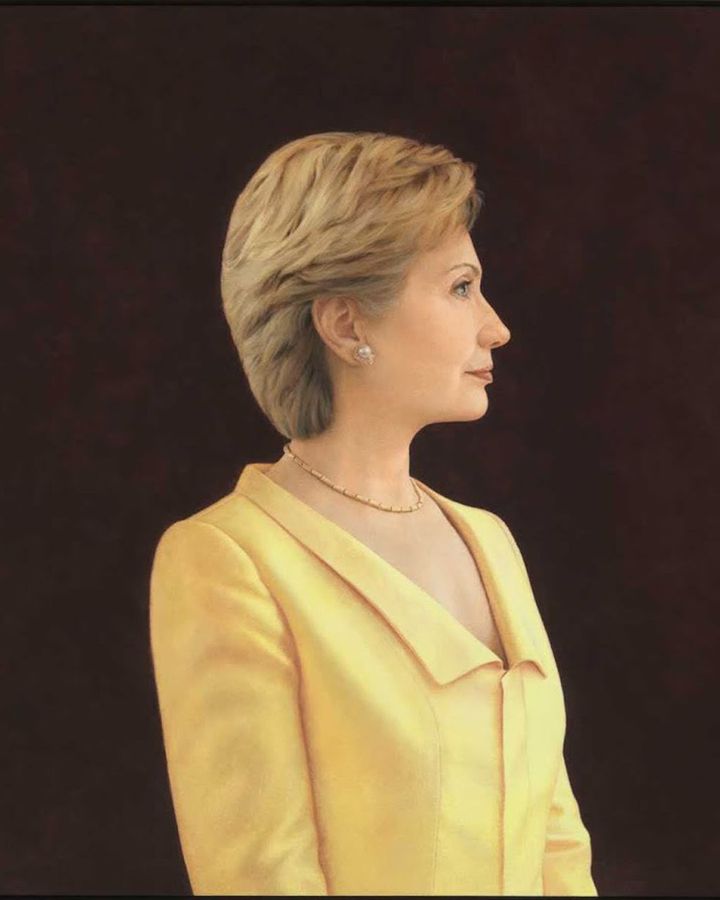
Hillary Clinton's supporters saw in her portrait a woman confident in her self-worth and ability (Credit: Ginny Stanford/ NPG/ Smithsonian Institution)
"We talk about addiction and recovery really differently today because she was so upfront about the challenges she faced in her life," says DuBois Shaw. Ford's vibrant portrait was painted in 1996, two years before she and her husband were awarded the Congressional Gold Medal, a testament to their enduring impact on US lives, although DuBois Shaw believes Mrs Ford's personal impact has extended much further. "She really had a global influence on people's lives."
Much like Eleanor Roosevelt, Hillary Rodham Clinton found herself facing a backlash from those suspicious of her level of influence and political ambitions. Her successor, Laura Bush, with her background as a school librarian and focus on child literacy programmes, was far more acceptable to the conservative cultural establishment. Bush is depicted smiling amiably at the viewer with a book lying open on her lap. Clinton in contrast is seen in stark profile, reminiscent of Italian Renaissance portraits of nobility. No doubt her detractors would consider it haughty, but her supporters will see a woman confident in her ability and self-worth. Painted in 2006 when the frustrations of the White House were long behind her, and the battle for the Presidency some years ahead, she had just been re-elected as senator for New York, having been the first ever woman to hold that position.
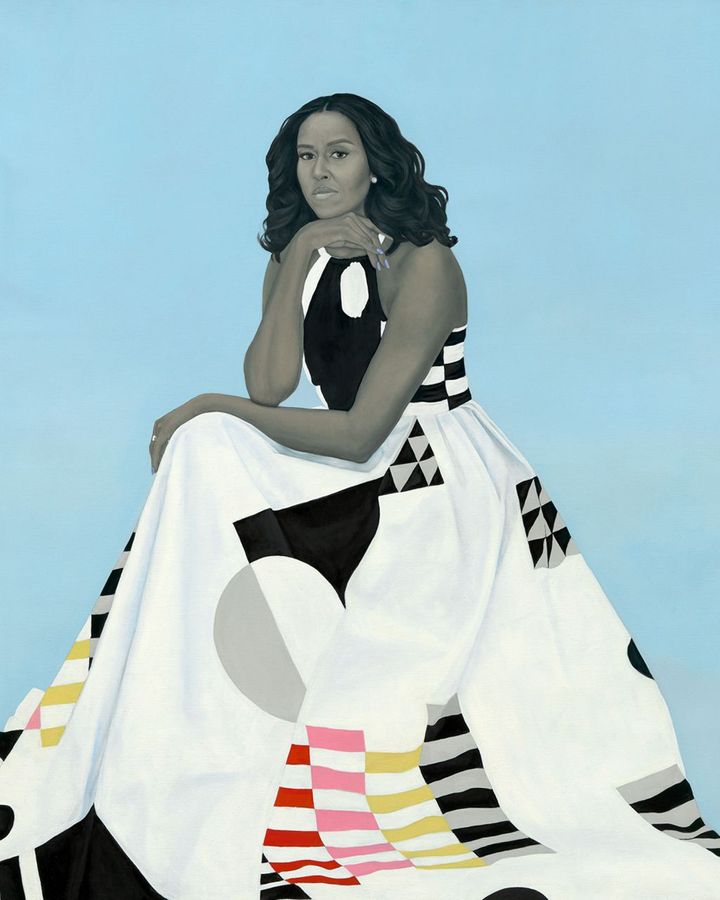
The portrait of Michelle Obama echoes her values in the choice of dress and artist (Credit: Amy Sherald)
Despite coming from a similar law background to Clinton, Michelle Obama's lack of interest in politics made her a far more popular first lady. Unquestionably aware of the cultural and historical significance of being the first African-American president and first lady, both Obamas chose black artists to paint their portraits. Amy Sherald's portrait, praised by President Obama for capturing his wife's grace, beauty, intelligence, charm and "hotness", also gained critical acclaim and has been hugely popular with museum visitors. DuBois Shaw sees the bond that Obama and Sherald formed as being key to the painting's success. "The comfort level really has to be there in order to get a portrait that tells you something more than just what this person looks like, to go into their personality, their persona and what their values are," she says. Those values are suggested by the dress she chose to wear. Designed by Michelle Smith, the vibrant patterns pay homage to the quilters of Gee's Bend, Alabama, many of whom are descended from former slaves.
Obama's tenure as first lady couldn't be further removed from Melania Trump's, who will chiefly be remembered for her disturbing Christmas decorations and controversial redesign of the rose garden. Given recent events in Washington, one wonders what will happen regarding her official portrait. For the exhibition she is represented by her official photograph, a steely-eyed, airbrushed shot, which, much like the woman herself, reveals very little in terms of personality.
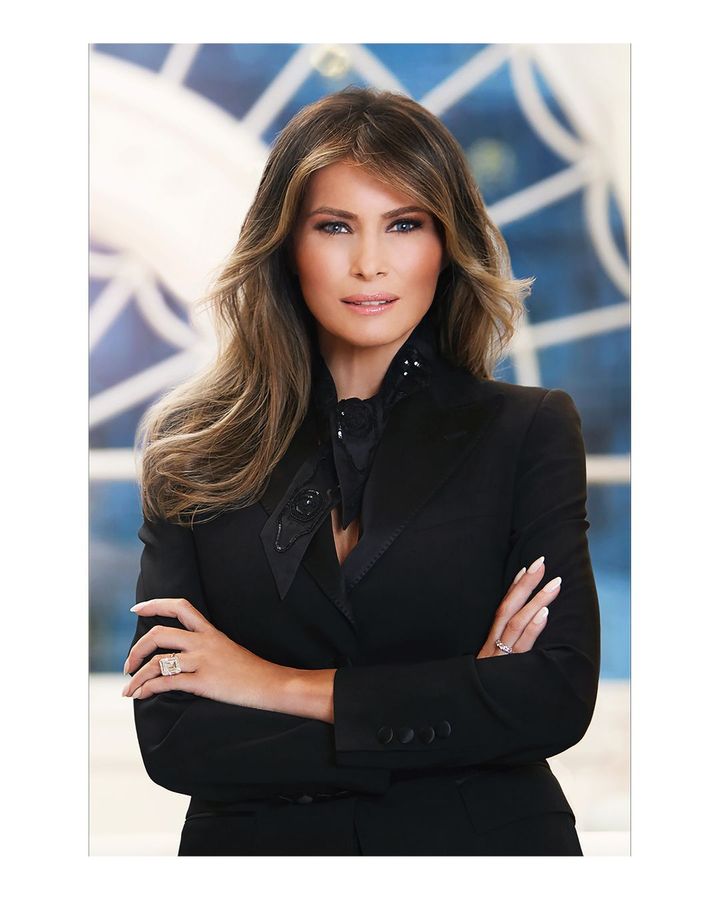
The official photograph of Melania Trump is steely-eyed, revealing little about the woman herself (Credit: Regine Mahaux-Van Wassenhove)
Jill Biden is going to be a quite different inhabitant of the role and no doubt her portrait will arouse great interest. But perhaps not as great an interest as that of her potential successor. For if Kamala Harris follows in Joe Biden's footsteps and becomes president, we will finally have in Doug Emhoff the subject of the first ever portrait of a first gentleman.
If you would like to comment on this story or anything else you have seen on BBC Culture, head over to our Facebook page or message us on Twitter.
And if you liked this story, sign up for the weekly bbc.com features newsletter, called The Essential List. A handpicked selection of stories from BBC Future, Culture, Worklife and Travel, delivered to your inbox every Friday.
"first" - Google News
January 18, 2021 at 10:11PM
https://ift.tt/3nVJEaP
The secret lives of the first ladies - BBC News
"first" - Google News
https://ift.tt/2QqCv4E
https://ift.tt/3bWWEYd
Bagikan Berita Ini














0 Response to "The secret lives of the first ladies - BBC News"
Post a Comment